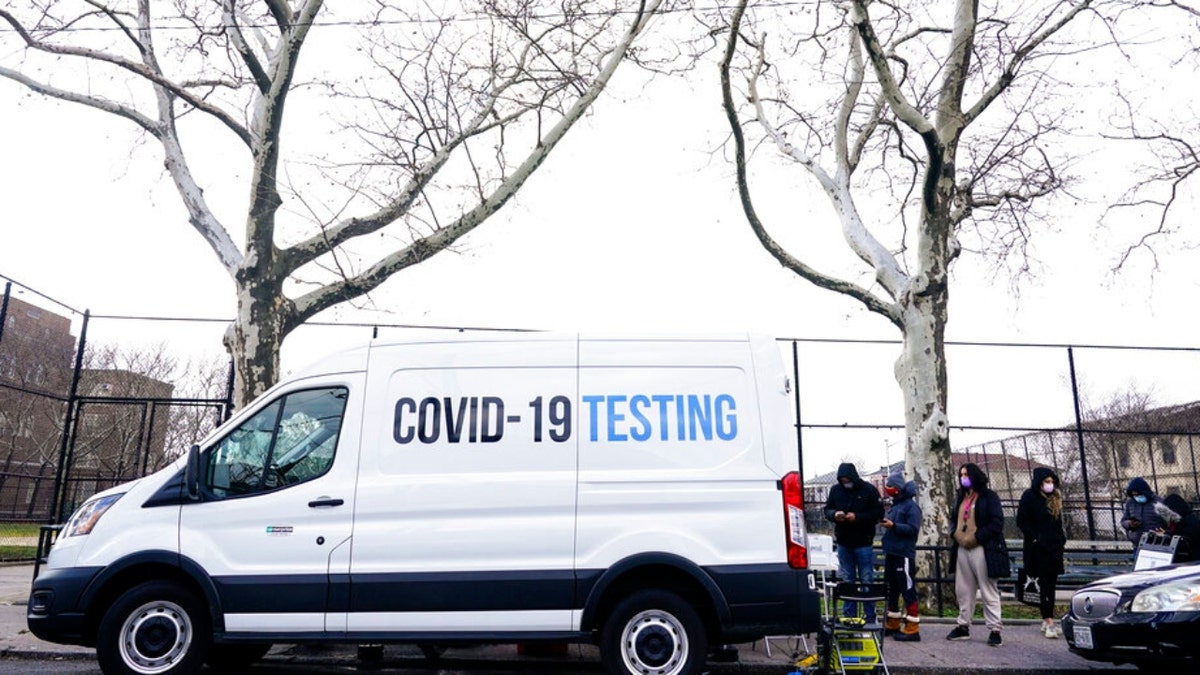Colorado residents wait in massive line for COVID-19 tests, video shows
Residents of a Denver suburb had to wait in a long COVID-19 testing line that stretched down a road and snaked through a parking lot on Wednesday. (Credit: Michele Fitzwilliam/@Shellymonstr/TMX)
The average number of COVID-19 tests per day is nearing record highs as Americans wait in hours-long lines around the country to get tested after the holidays.
The American Rescue Plan, ushered through Congress by the Biden administration last March, allocated $47.8 billion "to carry out activities to detect, diagnose, trace, and monitor SARS–CoV–2 and COVID–19 infections."
About 80% of those funds were gone by mid-December, according to U.S. Secretary of Health and Human Services Xavier Becerra.
"Are we going to have more than $10 billion worth of needs and costs? (With) COVID, especially regarding testing, there's a strong chance we will, depending on, again, where Omicron takes us," Becerra told reporters on Dec. 14, according to Reuters.
Since Dec. 14, the 7-day average for new daily cases has gone up nearly three-fold, surging from 119,356 to 316,277 new infections last Wednesday.

Hospital workers process COVID-19 tests at a hospital in Aiea, Hawaii, Wednesday, Sept. 15, 2021. (AP Photo/Caleb Jones)
America was closing in on a record number of new tests per day in December as the 7-day average for new tests hit 1,769,532 on Dec. 23.
CORONAVIRUS TESTING SITES PLAGUED WITH LONG WAITS AND LINES AS OMICRON SURGES: 'OVERWHELMING'
Prior to the American Rescue Plan, Congress allocated $25 billion in April 2020 as part of the Paycheck Protection Program to "research, develop, validate, manufacture, purchase, administer, and expand capacity for COVID–19 tests."
The roughly $73 billion allocated through these massive economic stimulus plans has been partly doled out to states, which can then use the money to distribute tests for local residents.
Connecticut announced a plan last week to use federal funds to purchase three million at-home tests made by iHealth Labs. Massachusetts announced a similar plan in mid-December to purchase 2.1 million at-home tests and distribute them to areas of the state with the highest percentage of people below the poverty level.

An aerial view of a long line is seen at a Covid-19 testing center next to the Queens Hospital Center as hundreds of residents get Covid-19 tests. (Photo by Tayfun Coskun/Anadolu Agency via Getty Images)
President Biden announced a plan last month to ramp up rapid antigen testing by making 500 million at-home tests available to anyone who wants them, but conceded that more work needed to be done.
"It's not enough. It's clearly not enough. If we'd have known, we'd have gone harder, quicker if we could have," he told governors last week.
WHITE HOUSE TURNED DOWN PLAN IN OCTOBER TO BOOST COVID TESTING: REPORT
Before that, the Biden administration announced a $650 million investment in November to "strengthen manufacturing capacity for quick, high-quality diagnostic testing."
In October, the Biden administration turned down a proposal by testing experts to produce 732 million rapid tests a month, according to Vanity Fair. Biden has denied the report.

People line up for at a CDC mobile COVID-19 testing location Thursday, Dec. 23, 2021, in the Queens borough of New York. (AP Photo/Frank Franklin II)
CLICK HERE TO GET THE FOX NEWS APP
The National Institutes of Health also established the Independent Test Assessment Program in October to "accelerate regulatory review and availability of high-quality, accurate, and reliable over-the-counter COVID-19 tests."
The first at-home rapid test wasn't approved by the FDA until roughly six months into the pandemic in November 2020. The FDA has since given emergency use authorization to about a dozen antigen over-the-counter at-home tests and three molecular at-home tests.





















